

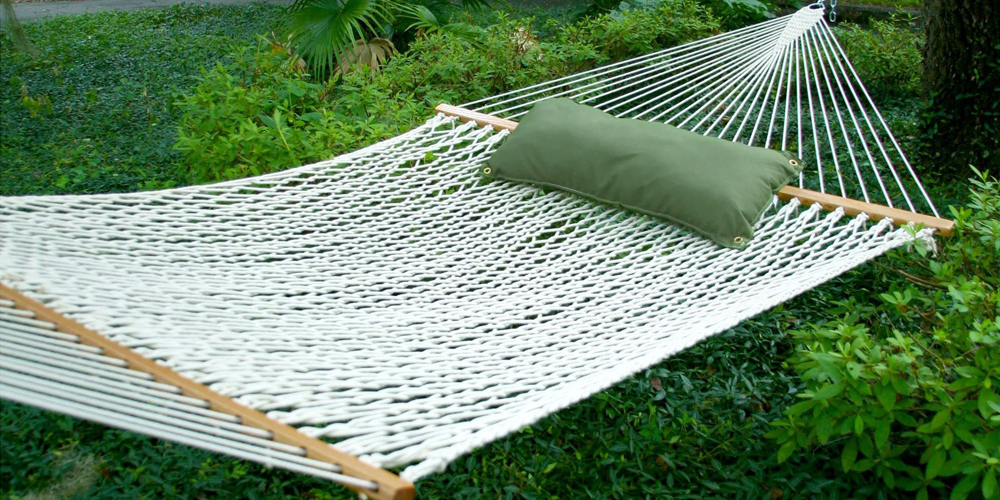
Hammocks are a great outdoor lounging option. Casual and comfortable, hammocks offer a spot to relax and unwind. There is a wide range of hammock styles, materials, and sizes to choose from, and choosing the hammock that best appeals to you rests on a number of factors. From selecting the best hammock option for your space, to learning about proper hammock care and hanging protocol, this hammock buying guide will help you through the process of purchasing this popular lounge product.
Hammock weight measurements can vary greatly, with support setups weighing between 7 oz. to several pounds and hammock beds supporting weights ranging between 150-500 lbs. A hammock’s weight capacity limit refers to static weight, and jumping onto hammocks should be avoided.
Hammock bed widths generally range between 4’ and 9’. Wider hammocks can sometimes accommodate up to four people, while capacity on smaller hammocks should be limited to one or two people for comfortable lounging.
Hammocks typically measure between 9’-14’ in length. Taller hammock users may want to look for a hammock with a longer length.
The ideal height for hanging a hammock depends on several factors. The spreader bars, the type of suspension system, and personal choice will all influence the overall height of the hammock. Aim to leave 18-24” between the lowest height of the hammock (when not in use) and the ground. The following chart outlines the ideal hanging height for a hammock based on its lengths and the distance between posts or trees.
|
Hammock Length |
Distance Between Trees or Posts |
|||||
|
|
Height of Tree Hooks (in Feet) |
|||||
|
|
10’ |
11’ |
12’ |
13’ |
14’ |
15’ |
|
9’ |
4 feet |
4 feet |
4 feet |
4 feet |
4 feet |
4 feet |
|
10’ |
4.5 feet |
4 feet |
4 feet |
4 feet |
4 feet |
4 feet |
|
11’ |
5.5 feet |
4.5 feet |
4 feet |
4 feet |
4 feet |
4 feet |
|
12’ |
|
6 feet |
5 feet |
4 feet |
4 feet |
4 feet |
|
13’ |
|
|
6 feet |
5 feet |
4 feet |
4 feet |
|
14’ |
|
|
|
6 feet |
5 feet |
4 feet |
One of the most important factors to consider when choosing a hammock is the suspension system. The suspension system not only influences the aesthetic of a hammock, but is critical to the safe use of these suspended lounge products. A typical suspension system includes carabiners to attach the anchoring hardware or suspension frame to the hammock itself. To allow for more versatility in placement and setup, hammocks with more attachment points are ideal for flexible use. Nylon ropes and web straps are commonly used suspension system methods.
Choose healthy trees with trunks at least 1’ in diameter. This ensures the trees are strong and supportive to carry the maximum capacity weight of the hammock
The best length or interval between trees that will support a hammock should be exactly or slightly greater than the entire length of the hammock (measured in feet) plus 1’. For example, a 7’ hammock will require a distance between trees of 8’.
Choose either straps or ropes as the suspension system
When ropes and hooks are used: First, create a small hole that measures at least 3/16 of an inch to install the hooks. Position the hook through the hole. Screw it in using a screwdriver. Screw the hook into the tree until you reach the eye (do not over screw). Repeat for each screw. Position screws at a height of about 4.5’ above the ground.
When straps are used: Thread the strap between the metal ring and loop the strap tightly around the tree. Thread the end of the strap back through the loop and use an “S” hook to secure the strap in place.
When selecting the ideal post, choose posts that will not decay or decompose over time. Make sure that Wood posts are treated with a coating to delay deterioration.
Opt for posts that measure more than 6” in diameter, and can be set within the ground at least 2-3’. This will ensure a stable hold.
Dig a hole where you would like to position each post, and place one post at the center of each hole. Soil with a compact and dense consistency is ideal properly hold and stabilize a hammock.
Allow cement to dry for 48 hours before installing and using the hammock.
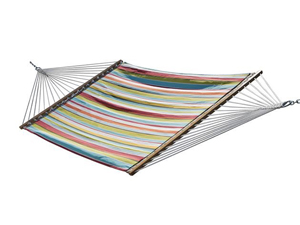
Spreader bars are located at both the head and the foot of a hammock, and determine the general width of the hammock. Their purpose is to keep the fabric of the hammock stretched laterally, creating the mostly flat surface that can be laid on. Spreader bars prevent the hammock from twisting or folding in on itself, and they can also contribute to the decorative design of the hammock. To ensure the bed will not be crooked or uneven, these types of hammocks require accuracy when hanging. Extend adjustable spreader bars an equal width at both the head and foot of the hammock.
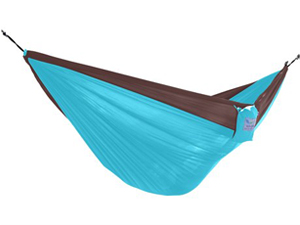
Without spreader bars, hammocks take on a cocoon-like appearance. These types of hammocks require less accuracy and rigidity in hanging. These hammocks support posts should be hung apart at a distance that is 2/3 the length of the hammock. When these hammocks are hung at a close distance between support posts, they must be raised higher from the group to eliminate the dip of the fabric from grazing the ground. These types of hammocks are not ideal for child use. Children may experience trouble climbing into and getting out of hammocks without spreader bars.
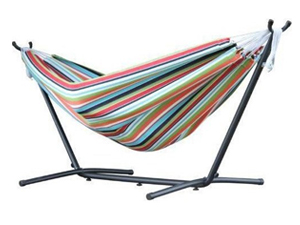
When proper support in the way of posts or trees is not available, a stand makes it easy to set up a hammock any place. Stands are self-supporting and typically crafted from wood or metal.
Hammock stands will vary in weight capacities. Ensure your hammock stand will hold a maximum of 450 lbs, and never exceed the weight capacity for your hammock stand.
The ideal size of a hammock stand should measure 2’ longer than the full length of the hammock. A hammock measuring 12’ will require a 14’ stand.
Metal and wood are the most common types of materials used to construct hammock stands.
Hammock stands that are constructed from wood are stable when cared for properly and have a natural, sought-after aesthetic.
Hammock stands constructed from metal will typically feature a durable powder coating that protects metal from corrosion or other wear. These stands are stable, lightweight, inexpensive, and can be moved easily.
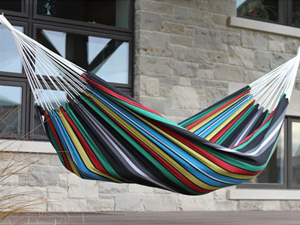
Ideal for chillier weather and regions
Provide the highest level of general comfort
Various fabric types and styles bring decorative value and other benefits:
Cotton: Soft, breathable, not resilient to outdoor elements (do not leave outside in extreme weather)
Canvas: Most sturdy, long-lasting fabric option, low maintenance
Polyester: Quick drying, durable, resistant to wear and tear from weather
Sunbrella: Proprietary fabric, resists color-fade, resists wear and tear from weather

Instead of lying down, hammock chairs (and hammock swings) prove ideal for customers who want to sit upright. The upright size make hammock chairs an ideal alternative to full-size hammocks. Less prone to flipping, hammock chairs area safe choice that is more stable than standard hammocks. Hammock chairs are cosntructed in the same materials avaiable for standard hammocks.

Ideal for hot or humid weather regions
Loose woven design allows air to flow through the product
Cool and comfortable
Will naturally stretch out over a long period of time
Will not accumulate leaves or other debris
Cotton is more comfortable than rope as a hammock material
Polyester is weather resistant; cotton is not
A polyester hammock will last longer and endure harsher conditions than a rope hammock
Polyester is a non-fading low maintenance material and will not collect mold mildew
DuraCord is a rope that is extremely durable, making it a popular hammock material. Resistant to fading, stains mildew, and mold, quick-drying, and non-absorbent, DuraCord merges the durable properties of polyester with the softness and comfort of cotton. DuraCord rope hammocks generally last longer than hammocks crafted from other materials.
Opt for an area that is thoroughly covered and shaded when deciding where to install your hammock. (Under an awning or beneath shade-casting trees). Limiting your hammock’s exposure to sun can extend the life of your product.
Do not exceed the weight limit capacity of a hammock or jump onto a hammock. This can stretch the hammock fabric, or break the suspension system.
Distribute weight evenly across the hammock bed to the best of your ability.
Do not sit or lay on the edge of a hammock, as it can flip over.
To clean hammocks contructed from rope, a simple detergent and warm water solution will work. You may soak the hammock in water and use a hard bristle brush, or use a mixture that consists of four parts soapy water with one part bleach for a more intensive clean. Spread the hammock flat after it has been washed. The hammock may shrink slightly as it continues to dry, but will quickly stretch back to its original size when used.
Keep spreader bars away from water.
Refinish wood hammock frames and spreaders periodically to help prevent wear and tear.
We recommend storing your hammock in a dry, climate-controlled location during the harsh winter months and extreme rain. Minimizing your hammock’s exposure to harsh weather conditions will help to extend the life of your product.



